
Pilot 9 - Analyse contamination levels in caught round goby
01 October 2024
The Baltic Sea is a heavily polluted water body and therefore the round goby population is vulnerable to toxic chemicals such as heavy metals (e.g., mercury, lead, and cadmium), and persistent organic pollutants (POPs) including dioxins, polychlorinated biphenyls (PCBs), polybrominated diphenyl ethers (PBDEs), and perfluoroalkyl and polyfluoroalkyl substances (PFAS). These substances can accumulate in the water and sediments, and can be absorbed by marine organisms, including fish. Due to their harmful effects on humans and wildlife it is crucial to monitor their levels to ensure safe fishing in the region.
Pilot owner: BIOR
Participating partners: DTU, FSK-PO, SLU, GMU, LIFE, Port of Władysławowo
Method:
Our partner BIOR will use validated and accredited methods to analyze contaminants in the round goby. For organic chemical contamination, gas or liquid chromatography coupled with high-resolution mass spectrometry is the preferred method, while inductively coupled plasma mass spectrometry will be used to measure elements at trace levels. To protect the health of consumers, the analysis will be carried out to ensure that the levels of these pollutants in caught round goby do not exceed the limits set by the European Union.
Fish quality and nutritional value can be indicated by lipid and protein content. Lipids are a significant source of energy and essential fatty acids, while higher protein content is associated with better quality and nutrition. Monitoring these levels can also provide information about changes in diet and environmental conditions. The Soxhlet method is commonly used to determine fat content, while the Dumas method is used for protein analysis.
All methods that will be used for analysis are validated and accredited. This means that the accuracy, precision, and reliability of the analytical methods have been verified, and meet international standards for laboratory quality management systems.
Samples will be selected based on size, age, location and depth, and will be collected during the different test fishing trials. A single laboratory sample should represent fish of the same age, size, and location from one catch. BIOR will collect approximately 300 laboratory samples to obtain reliable round goby contamination levels and ensure consumer safety.
Progress (April 2025):
In 2024, a total of 52 samples were collected from the Latvian commercial round goby fishery from the central Baltic Sea (38 samples) and the Gulf of Riga (14 samples). Each sample represents a specific size of round goby with an average estimated weight of 1,65 kg. The size and weight is later homogenized for further testing. So far, most of the testing for the Latvian samples is completed, with more time-consuming analyses, such as Dioxine tests will be conducted in autumn 2025. Also, the first four foreign samples from Sweden (Aspö, Karlskrona) have successfully been shipped to the BIOR laboratory that has started the testing process.
Interactive map showing pilot locations. Use the arrow keys to move the map view and the zoom controls to zoom in or out. Press the Tab key to navigate between markers. Press Enter or click a marker to view pilot project details.





